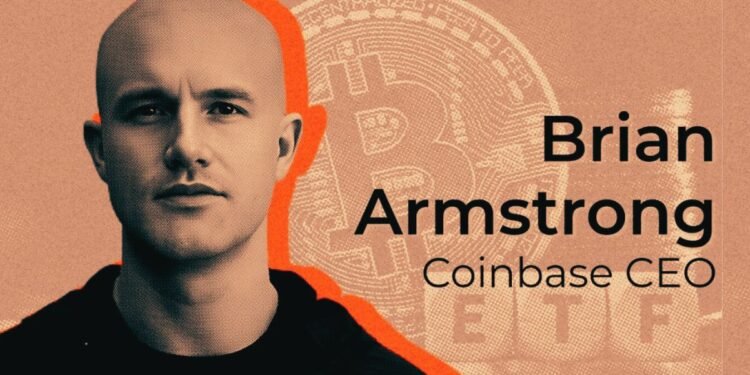On September 15, 2024, Coinbase CEO Brian Armstrong Tackles Bitcoin ETF Debate or Coinbase CEO Brian Armstrong addressed concerns surrounding Bitcoin ETFs, sparked by a tweet from Justin Sun questioning the centralization and transparency of these funds. Armstrong clarified Coinbase’s approach to managing ETF activities, emphasizing on-chain settlement for security. He also addressed proof of reserves and Deloitte audits, aiming to reassure institutional investors. While acknowledging centralized custody risks, Armstrong argued that it enables significant institutional participation in the Bitcoin market. The debate delves into the tension between centralization and the decentralized ethos of Bitcoin.
Brian Armstrong Clarifies Coinbase’s Approach to Bitcoin ETFs and Centralized Custody Issues..
Brian Armstrong took the opportunity to address how Coinbase manages Bitcoin ETFs and clarified the company’s approach toward centralized custody. He explained how Coinbase ensures transparency and security in its ETF operations.
- On-Chain Settlement: Armstrong emphasized that Coinbase’s ETF minting and burning activities are settled on-chain, providing transparency.
- Institutional Client Flexibility: Before finalizing on-chain settlements, institutional clients can use various options, such as trade financing and OTC trades.
- Auditing: Coinbase undergoes yearly audits by Deloitte, strengthening institutional investors’ confidence.
Coinbase’s On-Chain Settlement Process: Providing Transparency in ETF Management
Armstrong stressed that Coinbase’s ETF-related activities are settled on-chain, ensuring that every transaction is publicly verifiable on the blockchain. This process involves several key steps:
- Minting and Burning: When a Bitcoin ETF is created (minted) or removed (burned), these actions are recorded on the blockchain. This transparent process helps to prevent unauthorized activity.
- Institutional Options: Institutional clients have access to options like trade financing and OTC trades before final settlement. This allows for more flexibility in managing large transactions without compromising on-chain security.
- Final Settlement: After utilizing these options, final settlement occurs on-chain. This means that the ultimate record of all ETF transactions is immutable and publicly accessible, enhancing trust.
By adopting this approach, Coinbase aims to blend the flexibility required by large investors with the transparency and security benefits of blockchain technology.
Addressing Proof of Reserves and Yearly Audits: Enhancing Trust in Coinbase’s ETF Operations
Armstrong tackled concerns about the proof of reserves, a crucial aspect in the cryptocurrency space where transparency and trust are vital. Here’s how Coinbase addresses these concerns:
| Key Aspect | Explanation |
|---|---|
| Proof of Reserves | Ensures that the exchange holds enough assets to cover all user balances. Coinbase’s operations are transparently conducted on-chain. |
| Yearly Audits by Deloitte | Coinbase is audited annually by Deloitte, a reputable auditing firm, adding a layer of security and legitimacy. |
| Centralized Custody Risks | Armstrong acknowledged inherent risks but highlighted that this model allows significant institutional capital to enter the market. |
By having a well-established proof of reserves mechanism and undergoing yearly audits by Deloitte, Coinbase aims to strengthen the confidence of its users, particularly institutional investors who require a high level of trust and security. This process shows that while Coinbase operates as a centralized entity, it strives for transparency and reliability.
The Centralization Debate: Balancing Security and the Core Principles of Bitcoin
The debate on centralized Bitcoin ETFs touches on a fundamental issue within the cryptocurrency community: the tension between security and decentralization. Armstrong’s comments highlight this intricate balance:
Risks and Benefits of Centralized Custody in Bitcoin ETFs
Centralized custody involves a single entity (in this case, Coinbase) holding and managing assets. Armstrong acknowledged the risks but also pointed out the necessity of this structure for large-scale investment:
- Inherent Risks: Centralized control means that a single entity has the power to manage assets, which can be viewed as a point of vulnerability. Risks include potential hacking, regulatory intervention, and freezing of assets.
- Institutional Involvement: Armstrong argued that centralized custody allows significant institutional capital to flow into the Bitcoin market. This influx is crucial for market growth and maturity, enabling greater adoption.
- Enhanced Security Measures: By adopting rigorous security protocols, regular audits, and transparent operations, Coinbase aims to mitigate the risks associated with centralized custody.
The Tension Between Decentralization and Centralized Solutions
The cryptocurrency community values decentralization, which is at odds with the centralized model of ETFs. Armstrong’s stance raises several points:
- Trust in Centralization: Centralized solutions require trust in the custodian, which contrasts with Bitcoin’s original ethos of trustless transactions. Armstrong emphasized that Coinbase has never claimed to operate differently, acknowledging the trade-offs involved.
- Decentralization Concerns: Many crypto enthusiasts worry about the centralization of assets, as it could undermine the very principles that Bitcoin was built upon. This tension remains a topic of ongoing debate.
- Open Process and Audits: Despite these concerns, Coinbase’s open process and annual audits attempt to bridge the gap between centralized management and decentralized ideals.
In summary, Armstrong’s perspective offers a pragmatic approach: while centralized custody comes with inherent risks, it plays a crucial role in driving institutional investment and adoption of Bitcoin, potentially paving the way for its global influence.






